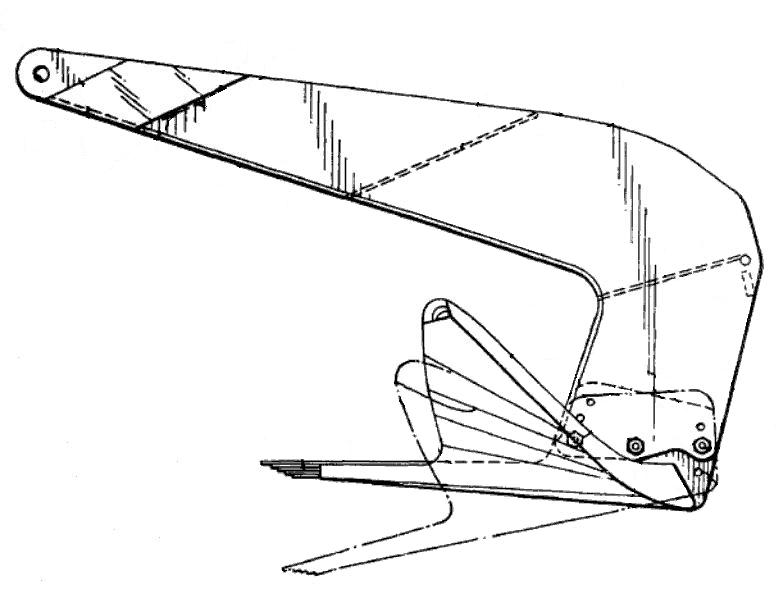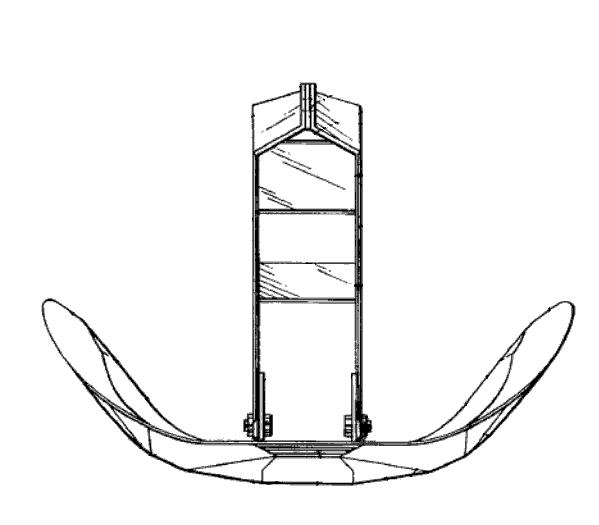The recreational or leisure marine market Bruce Anchor is no longer in production. The company is still in business; they are serving the offshore oil industry.
Website here: Bruce Anchor Peter Bruce's US patent 4,397,256 was awarded in 1983. Surprisingly, the production anchor differs greatly from the patented design in three major ways: {1} patent design has a double-plate girder/box-beam for the shank ("the above double-plate girder shank on the one hand provides increased resistance to bending moments in vertical and sideways directions and on the other hand enables satisfactory soil penetration by the shank due to the open construction"); {2} patent anchor has a shank that is removable at the attachment point to the flukes; and {3} variable fluke angles ("including bolted attachment means securing the fluke to the shank and having a plurality of bolt holes positioned to allow bolt attachment of the anchor fluke in a plurality of angular positions relative to the shank for variation of the fluke angle of attack"). See for yourself below. While the Bruce Anchor was invented in Scotland to secure floating oil rigs, that behemoth version--see pic below--bears no resemblance at all to the anchor design for the recreational marine market . The superiority of the Bruce's shape gives it tremendous efficiency, particularly on short scope over a variety of bottom conditions. Based upon field testing and engineering studies, Lloyds of London approved the replacement of a 45,000 pound conventional oil rig anchor with a 14,331 pound Bruce. The Bruce has earned an Award of Special Merit for Engineering Products Award from the Design Council (London, 1978). Constructed of a single piece of cast steel, each Bruce Anchor has no movable parts nor any flimsy components. This allows each to be covered by a lifetime warranty against breakage. Absolute Roll Stability Every anchor has an upright orientation at which maximum holding power is achieved. Changes in wind or tide cause the angle of pull to change and to roll the anchor onto its side. A good anchor resets itself quickly to achieve upright orientation. The Bruce Anchor rolls upright. irrespective of initial drop attitude, within 2 shank lengths after engaging the sea bed and, at a rode-angle of up to 30 degrees (ultra short scope), begins burial. Full Veering Capability The curved wingtips and point are configured so that pull on the rode automatically rolls the Bruce to its optimum upright orientation, whether for initial setting or resetting. This capability is important in minimizing dragging when wind or tide change. Instead of breaking out, the Bruce can remain embedded as it veers. The Bruce banks in the sea bed and maintains high holding power, even through 360 degrees. Short-Scope Holding Power The Bruce Anchor will bury in the sea bed at rode-angles up to 30 degrees (at the anchor shackle) where most other anchors require 10-15 degrees. In crowded anchorages or in deep water, this distinction means more than a peaceful night" it can become a yacht or life-saver. The reason for the Bruce's better performance with short scope as its design: the center of fluke area is located much closer to the forward end of the fluke than is possible in other anchor designs. Among Rocks and Coral The Bruce works well in bottom conditions where many anchors are ill-suited. Among the worst conditions are rocks and coral. Here, the Bruce Anchor's three strong points let this anchor grab as easily as the Fisherman type. And because there are no flimsy or moving parts, there's less risk of bending or jamming. In fact, the one-piece construction in heat-treated cast steel gives the Bruce greater strength than any other patented anchor of similar weight. Easy to Recover and Stow Despite the superior burying and holding power, the Bruce is easily broken out for hauling. The short, broad single fluke gives rise to small shear moments in the sea bed when the anchor is rotated upward during hauling. The Bruce is very compact. Because of its inherent roll stability, it required no stock and thus is narrower. It has no moving parts to secure, and stows easily and conventionally in a bow roller system. Customer Testimonials "I've held with a 33 pound Bruce in 100 knot winds. The best feature is the Bruce holds in kelp. We have every kind of bottom known to man. Cordova is the best test for anchors. The Bruce in the answer." Tom Copeland, Cordova, AK, 38 foot Wigley seiner "MJB". "The Bruce is the best anchor made. It sets right now. I've been in the Farallon Islands on a rock bottom, Drakes Bay and Ballenas Bay on mud and grass, San Pablo Bay on mud, Santa Cruz on sand. The Bruce never dragged, never fouled. I've never lost any sleep." Lee Oberholser, Freyer Marine Co. boat charters. "We've been anchored in coral, sand, mud, kelp, and rock. The Bruce is the only anchor I use. It sets within 20 feet. I've never slipped with it. The Bruce is the best anchor on the market." Jim Innes, Vancouver, B.C. 53 foot 30,000 pound sailboat, "Cuckoo's Nest", 40 pound Bruce anchor. "We cruise in the Queen Charlotte Islands, where there's a lot of rock bottom. I've never had a problem anchoring, I've never had a problem pulling up. I recommend the Bruce". Larry Baily, Seattle, WA, Sceptre 41 "Shinglebiss", 33 pound Bruce anchor. "We've had our Bruce for four years. In weed it's phenomenal. We drop, set and go below. We watch boats with other anchors try, de-weed, and try again. We call them farmers-we're relaxing, they're plowing." Dale Muggli, Federal Way, WA, Fantasia 35 cutter, 23,000 pounds, 22 pound Bruce anchor. "In 1984 we anchored in MacKay Harbor at the south end of Lopez Island. The wind came in strongly and we spun around all night. Most of the other boats dragged. We didn't. Now I sleep at night." Laurie McDonald, Seattle, WA, Cal 25 mkII, 16.5 pound Bruce. "Twice we've anchored in kelp with a 3:1 scope and held in 55 knot winds. We've never found a bottom we couldn't anchor in. We used to have another brand of anchor; we gave it away." Chuck and Laurie Driver, Seattle, WA, Cal 34 "Crescendo", 22 pound Bruce anchor. "Bristol Bay is hard anchoring. It's 6 - 15 feet deep, lots of sea, currents to 8 knots. Our Bruce grabs every time. It bites quick, and cleans easily. If we lost our Bruce we'd be unhappy. I'm glad someone made it. It's the best anchor around." Jeff LaMaine, Seattle, 32-foot Bristol Bay boat, 33 pound anchor. "I've fished off the Washington coast for three years, and I've taken two trips to Alaska and back. My Bruce anchor has held with a 2:1 scope in God's Pocket with ocean surge against a rock wall. I have confidence in the Bruce. I don't even keep an anchor watch any more." William Ovens, Seattle, WA, 32-foot commercial hull converted to yacht use, 33 pound Bruce anchor. "We can cruise in the San Juan Islands and Puget Sound. We kick the Bruce over and forget it. We raft 2 - 3 boats off it. This is my second Bruce anchor. That's an endorsement, isn't it?" Bill and Cappy Buss, Kent, WA, 40-foot Cruise-a-Home "Cappy Can". "Normal scope is 3:1, and we never drag. A C & C 41 rafted to us one night in 25-30 knot winds and we didn't drag. We sleep. We don't worry a single bit." Bernard and June Francis, Bremerton, WA, Pearson 323, "Quest".    |